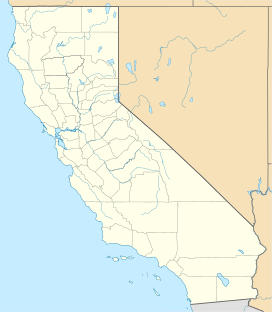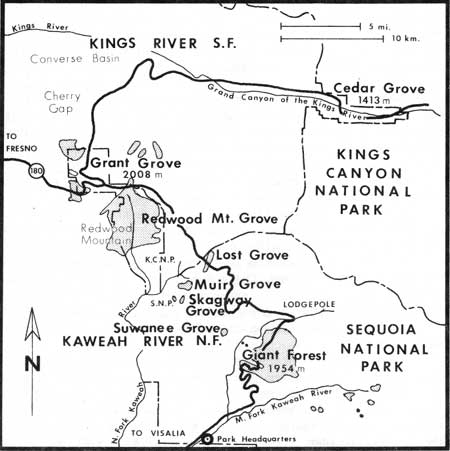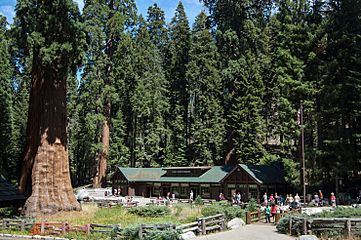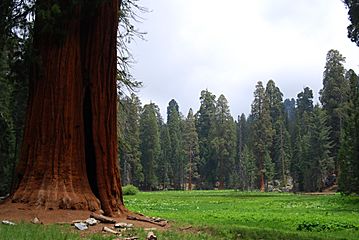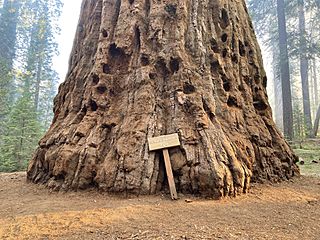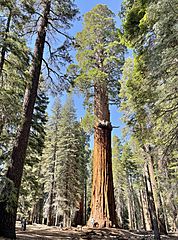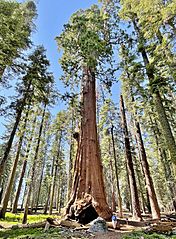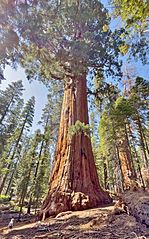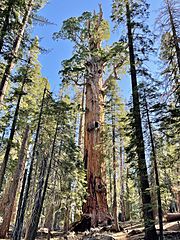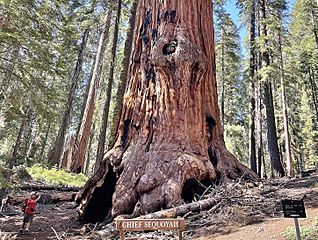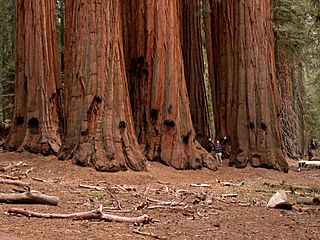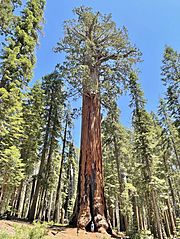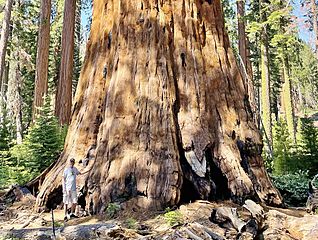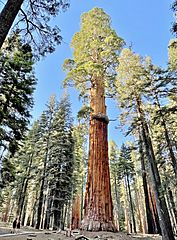Giant Forest facts for kids
Quick facts for kids Giant Forest |
|
|---|---|
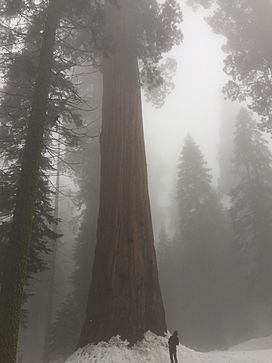
Giant sequoia trees in the Giant Forest, March 2019
|
|
| Map | |
| Geography | |
| Location | Sequoia National Park, California, United States |
| Coordinates | 36°33′45″N 118°45′05″W / 36.562445°N 118.751487°W |
| Elevation | 6,990 feet (2,100 m) |
| Area | 1,880 acres (7.6 km2) |
| Ecology | |
| WWF Classification | Sierra Nevada forests |
| Dominant tree species | Sequoiadendron giganteum |
The Giant Forest is a super cool place found inside Sequoia National Park in the United States. It's famous for its amazing giant sequoia trees. These huge trees grow in a montane forest (a forest in the mountains) in California.
The forest is high up, more than 6,000 ft (1,800 m) above sea level. It covers a large area of 1,880 acres (7.6 km2). The Giant Forest is easy to visit because it has over 40 mi (64 km) of hiking trails for everyone to explore.
Did you know that five of the ten biggest trees on Earth live here? The biggest one is called the General Sherman. Its base is 36.5 ft (11.1 m) wide! Giant sequoias are the most massive trees in the world.
They are also one of only six types of trees that can grow taller than 300 ft (91 m). Other tall trees include coast redwood and Douglas fir. Giant sequoias are also some of the longest-living trees on our planet!
Contents
Exploring the Giant Forest Area
The Giant Forest is close to other cool spots in the park. You can find Crystal Cave, Moro Rock, and Crescent Meadow nearby. These are all great places to visit.
A long hiking path called the High Sierra Trail starts at Crescent Meadow. This trail goes all the way across the Sierra Nevada mountains to Mount Whitney.
Plants and Animals in the Forest
You'll see many different kinds of trees here. Some common ones are Ponderosa, Jeffrey, Sugar, and Lodgepole pine trees. There are also white and red fir trees.
Keep an eye out for animals too! Visitors often spot mule deer, Douglas squirrels, and American black bears. The National Park Service wants you to be careful with food. Bears might try to break into cars if they smell food inside!
The Giant Forest is special because it has large, wet meadows called fen meadows. These include Round Meadow, Crescent Meadow, and Circle Meadow. They help store water for the forest.
Giant Forest Village: A Place to Visit
When you come from the south, you'll first see the giant sequoia trees near Giant Forest Village. This is a small group of buildings that looks tiny next to the huge trees.
Some of the sequoias here became unstable because of buildings near their roots. So, many visitor services, like places to stay overnight, were moved. Now, you can find lodging at Wuksachi Village, about 7 miles (11 km) north.
The main part of the sequoia forest is east of the village. You can get there by a three-mile (4.8 km) side road or by walking on many trails. These trails are between one to five miles (1.6 to 8.0 km) long. They lead to different famous trees and groups of trees.
The forest usually gets a lot of rain, which helps the sequoias grow so big. But these wet conditions also mean there are many mosquitoes, especially during most of the year. So, bring bug spray! The paths are usually flat and shady, making them nice to walk on.
History of the Giant Forest
Long ago, there were almost 300 buildings in the Giant Forest area. Today, only four buildings remain, and there are no shops or businesses. It's now a "day use" area, meaning you can visit during the day but not stay overnight in the grove itself.
Between 1995 and 2000, many buildings were taken down. This helped restore the area to its natural state. Now, park rangers can use controlled fires to manage the forest, which helps new sequoia seedlings grow.
How to Get to Giant Forest
You can reach the Giant Forest from Fresno by taking State Route 180. Or, if you're coming from Visalia, you can take State Route 198.
The Generals' Highway connects the Giant Forest to Kings Canyon National Park. In Kings Canyon, you can find the General Grant tree and other giant sequoias.
Famous Trees You Should See
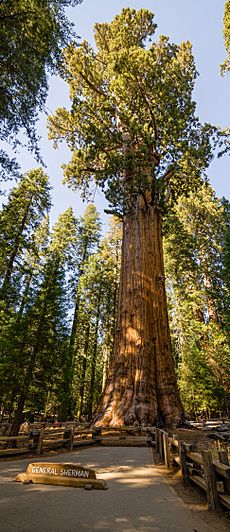
Here are some of the most amazing trees in the Giant Forest:
- General Sherman: In 1931, this tree was named the largest living thing on Earth! It has a huge volume of 52,508 cubic feet (1,486.9 cubic meters). Its biggest branch is about 7 feet (2.1 m) wide. The second-largest tree, the General Grant, is about 27 miles away in Kings Canyon National Park.
- President: Experts who climbed this tree recently found that it's even bigger than the General Grant tree! It's starting to come close to the General Sherman Tree in size.
- Congress group: This is a group of trees located between the General Sherman Tree and the Giant Forest Museum. It's divided into "The House" and "The Senate." The Congress Grove is near the President Tree. In 1922, a park superintendent named the Senate trees to honor the United States Senate. You can take an easy 2 miles (3.2 km) walk on the Congress Trail to see The Senate.
- Chief Sequoyah: Just uphill from the President tree, you'll find the massive Chief Sequoyah. This tree looks very strong and rugged.
- Lincoln: This is the fourth-largest tree in the world, with a volume of 44,471 cubic feet (1,259.3 cubic meters).
- Franklin: Even though it's the eighth-largest tree in the world, it's sometimes overlooked because it's in a grove with so many other huge trees. This tree has a big burn mark from a fire on one side.
- Monroe: This tree is the tenth-largest in the world.
- General Pershing: This tree has a very wide lower trunk, but its top is a dead, tapering snag.
- Column Tree: About 100 yards (91 m) from the General Pershing tree is another large sequoia. It's the fourteenth-largest giant sequoia because its trunk doesn't get much narrower as it goes up.
- Adams Tree: From about 90 feet (27 m) up, this tree's trunk is very bumpy with many branches and leaves. The top is a maze of limbs.
- Cleveland Tree: This is one of the 40 largest giant sequoias.
- Hamilton: A large tree with a volume of 32,783 cubic feet (928.3 cubic meters).
- Near Ed by Ned: This tree has an impressive lower trunk. In 1997, it was measured at a volume of 30,333 cubic feet (858.9 cubic meters). It's located 46 m (151 ft) north of Ed by Ned, which is how it got its name.
- Ed by Ned: This is a pair of giant sequoia trees that are intertwined. They are at the south end of Round Meadow and are also known as the "Uncle Ned Tree."
- Hazelwood Tree: This was a very large tree, but lightning damaged it in 2002, cutting its size in half. It's still alive though!
- Washington tree: This tree was once the second-largest tree in the world. But a fire in 2003 and a snowstorm in 2005 caused it to lose most of its trunk and size. It's no longer one of the biggest.
- Unnamed Tree: This tree doesn't have a name, but it's unusually tall, measuring 303.4 feet (92.5 m). It's the largest known sequoia to be over 300 feet (91 m) tall.
Gallery
-
The Giant Forest Museum with the Sentinel Tree (far left)
See also
- List of largest giant sequoias
- List of giant sequoia groves
- List of individual trees
- Washington (tree)


